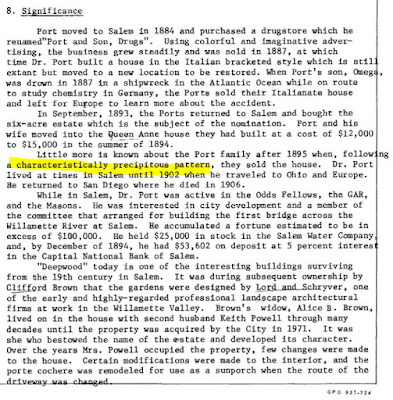The question of how Deepwood has been understood in our history remains interesting. The approach taken by Ben Maxwell in 1956 seems indicative. He had a different go-to metaphor for the 1890s.
 |
| October 24th, 1956 |
He says the home "dates from Mauve decade."
 |
| "Mauve decade," 1926 |
We don't hear that phrase much any more, but it seems to date from the 1926 book on fin de siecle culture in America. On the surface that looks like an author in the "roaring 20s" looked back the "gay 90s" for a positive take on the end of the Gilded Era.
 |
| gay 90s imagery as "mauve decade" (Oct. 19th, 1933) |
A similar book written in the early 1930s might have had a very different focus, though the phrase "mauve decade" was used during the Depression. In a photo caption for a costume party, two are described as "exquisites of the 'mauve decade'."
In the 1940s and 50s Ben Maxwell often used the phrase in his history columns. It was a characteristic metaphor he used for the era - a literal instance of seeking color to enliven history. And as best as I can tell, he never uses the phrase Panic of 1893.
 |
| David Duniway on Deepwood |
Writing around 1970, in his Nomination for Deepwood to the National Register of Historic Places, and citing Maxwell's 1956 piece, David Duniway writes around the Panic of 1893. He does not mention it at all, and says only that the Port family sold the house in 1895 "following a characteristically precipitous pattern." As I read it, this primarily refers to the mobility and sudden moves of the family, but might also be a glancing reference to the depression.
Even so, the reference to Dr. Port's wealth held at the Capital National Bank stresses immunity to the Panic and depression.
The Maxwell piece from 1956 says that Port purchased the lot from "J. H. Albert, Salem captalist." Both father John and son Joseph had the middle initial H, but I think this refers to John H. Albert. They had platted the University Park Addition, and perhaps then also the Yew Park Addition, just south of University Park, on which Deepwood is located. (See here for more on the Albert family's move from Court Street to Winter Street and University Park.) So it interesting to note that Port banked with the family at the Capital National Bank, also. That connection may be multi-layered.
Another place to look for the Panic of 1893 is the regular history columns, "Bits for Breakfast" in the morning paper during the 1930s.
The Bitsman hardly mentioned it! Instead, there were a few editorials, probably written by Charles Sprague rather than the Bitsman, but nearly always in the context of national politics, and rarely very localized.
 |
| March 12th, 1933 and May 21st, 1931 |
One editorial did mention the problems for farming and farmers that the depression caused, but again not really localized, mentioning the Mississippi valley, Nebraska, Kansas, Texas, Montana...and only finally at the end in one short paragraph referring to the Willamette valley:
Have faith in the land. It is the foundation of the country and a root of prosperity. Certainly in this Willamette valley with its possibilities of diversification, its nearness to market, land values cannot remain permanently on panic levels.
This refers to current land values in 1931 rather than those of 1893.
It sure looks like there's a real hole around the Panic of 1893, almost like it was deliberately shoved down the memory hole.
Once source I read several months ago, and failed to write down then, suggested the Panic of 1893 and depression were not as severe here. This is possible, and could be another reason it is not written about as much. Still, you'd think there would be more language like, "while the Panic of 1893 was terrible around the country, here in Salem it was not so bad." You'd expect more explicit acknowledgement of local difference with uneven effects.
I think there's a story here. I am not sure yet what exactly that story is, but the thinness on the Panic of 1893 in local popular history is remarkable.
Additional things to check in the future:
-
Duniway's later 1989 book on Luke Port and Deepwood
- "Woodburn in the Gay Nineties" by Della B. Stamps in the 1957 Marion County History, vol. 3
It's disappointing those Marion County History volumes aren't digitized, since nearly all of them are out of print.


No comments:
Post a Comment